Comparative Analysis of Advocacy and Social Action Models (MSWPG 7214)
VerifiedAdded on 2023/04/06
|15
|3403
|253
Essay
AI Summary
This sociology assignment presents a comparative analysis of two models of advocacy and two models of social action, utilizing real-world case studies to illustrate their application and impact. The essay begins with an introduction to sociological theories and paradigms, framing the context for the models. It then delves into two advocacy models, examining cases involving disability services in Australia, and the challenges faced by individuals in residential care and community services. The analysis includes a comparative evaluation of the models, drawing upon theories of empowerment and conflict. Following this, the essay explores two models of social action, highlighting the 'Changing the Face of Beauty' campaign and the controversy surrounding 'Cecil the Lion'. A comparative analysis of these social action models is then undertaken, incorporating functional and conflict theories. The assignment emphasizes the effectiveness of these models in bringing about social change and empowering individuals and communities, offering a comprehensive understanding of advocacy and social action within the sociological framework.
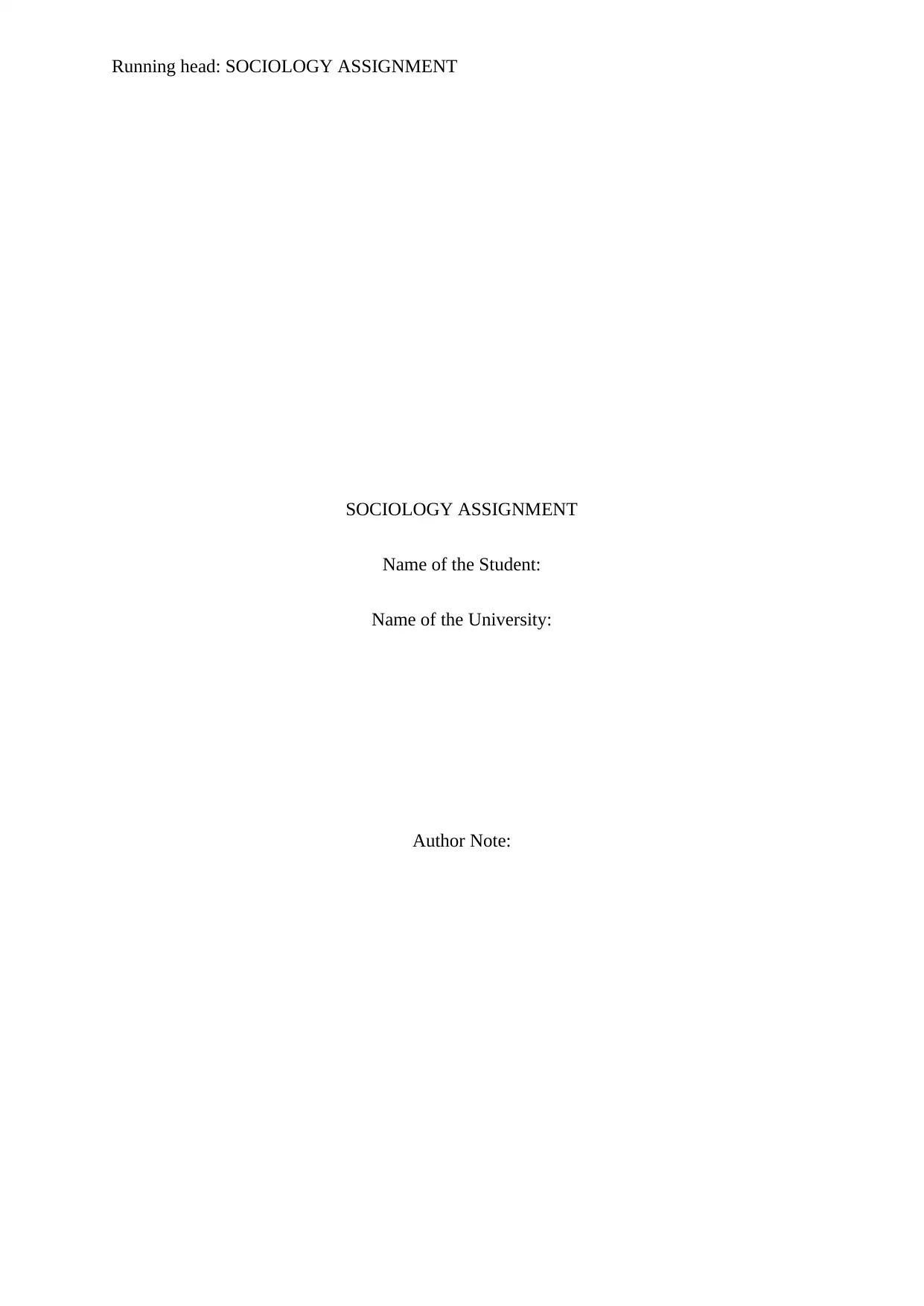
Running head: SOCIOLOGY ASSIGNMENT
SOCIOLOGY ASSIGNMENT
Name of the Student:
Name of the University:
Author Note:
SOCIOLOGY ASSIGNMENT
Name of the Student:
Name of the University:
Author Note:
Paraphrase This Document
Need a fresh take? Get an instant paraphrase of this document with our AI Paraphraser

1SOCIOLOGY ASSIGNMENT
Introduction:
According to Barnes (2013), a theory in sociology attempts to investigate a process
and critically explain the underlying mechanism of the manner in which the process operates.
Sociology exclusively attempts to evaluate the form of social interaction so as to develop a
hypothesis about the society. Theories in sociology are widely studied under different level
which focus on issues ranging from small scale to large scale targeting existing relationships
between individuals or communities. It should be noted in this context that Grand theories
provide an explanation on why societies form and what determines the change in the societal
structures. On the other hand, Paradigms constitute the theoretical frameworks that are used
for formulating sociological theories, generalizing them and conducting social experiments to
support the theories (Bulmer, 2017). The structural functionalism, conflict theory and the
symbolic interactionism form the three paradigms that dominate sociological thinking. In
relation to this, it should be mentioned that the parameters of advocacy as well as democratic
practice direct people to overcome obstacles so as to acquire social justice. This forms the
basis of the model of advocacy where sociologists enable people to develop a better
understanding through empowerment so as to ensure better decision making and acquire firm
control over the lives (Mouzelis, 2016). Also, the social action model targets at uplifting the
oppressed and underprivileged communities through empowerment, collaboration
partnership, alliances and high impact action plans (Denzin, 2017). This paper would
critically present two case studies based on the model of advocacy and social action. The
paper would further evaluate the case studies based upon the underpinning theories and
conduct a comparative analysis so as to develop a better understanding about the two models
in the field of sociology.
Introduction:
According to Barnes (2013), a theory in sociology attempts to investigate a process
and critically explain the underlying mechanism of the manner in which the process operates.
Sociology exclusively attempts to evaluate the form of social interaction so as to develop a
hypothesis about the society. Theories in sociology are widely studied under different level
which focus on issues ranging from small scale to large scale targeting existing relationships
between individuals or communities. It should be noted in this context that Grand theories
provide an explanation on why societies form and what determines the change in the societal
structures. On the other hand, Paradigms constitute the theoretical frameworks that are used
for formulating sociological theories, generalizing them and conducting social experiments to
support the theories (Bulmer, 2017). The structural functionalism, conflict theory and the
symbolic interactionism form the three paradigms that dominate sociological thinking. In
relation to this, it should be mentioned that the parameters of advocacy as well as democratic
practice direct people to overcome obstacles so as to acquire social justice. This forms the
basis of the model of advocacy where sociologists enable people to develop a better
understanding through empowerment so as to ensure better decision making and acquire firm
control over the lives (Mouzelis, 2016). Also, the social action model targets at uplifting the
oppressed and underprivileged communities through empowerment, collaboration
partnership, alliances and high impact action plans (Denzin, 2017). This paper would
critically present two case studies based on the model of advocacy and social action. The
paper would further evaluate the case studies based upon the underpinning theories and
conduct a comparative analysis so as to develop a better understanding about the two models
in the field of sociology.

2SOCIOLOGY ASSIGNMENT
⊘ This is a preview!⊘
Do you want full access?
Subscribe today to unlock all pages.

Trusted by 1+ million students worldwide
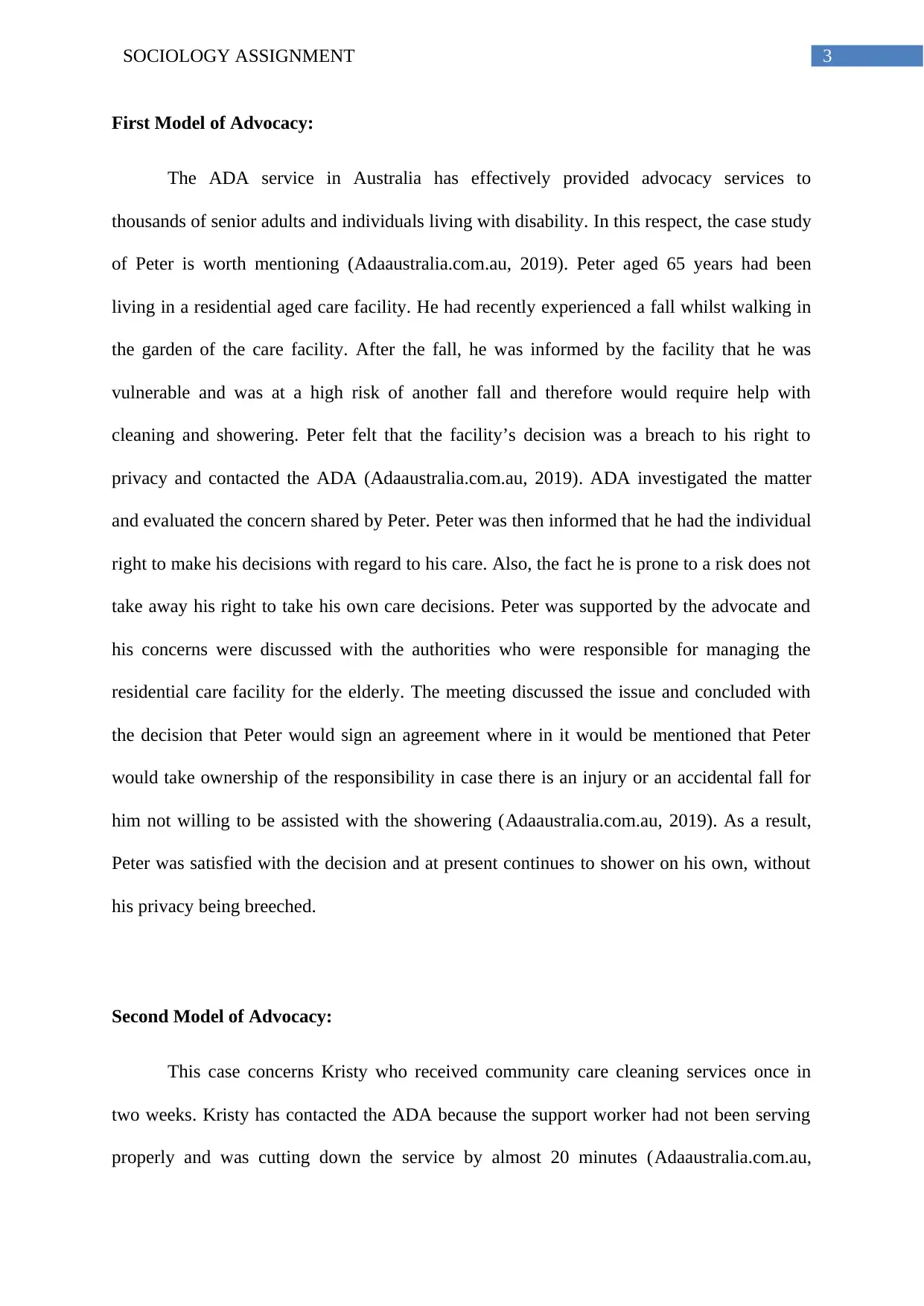
3SOCIOLOGY ASSIGNMENT
First Model of Advocacy:
The ADA service in Australia has effectively provided advocacy services to
thousands of senior adults and individuals living with disability. In this respect, the case study
of Peter is worth mentioning (Adaaustralia.com.au, 2019). Peter aged 65 years had been
living in a residential aged care facility. He had recently experienced a fall whilst walking in
the garden of the care facility. After the fall, he was informed by the facility that he was
vulnerable and was at a high risk of another fall and therefore would require help with
cleaning and showering. Peter felt that the facility’s decision was a breach to his right to
privacy and contacted the ADA (Adaaustralia.com.au, 2019). ADA investigated the matter
and evaluated the concern shared by Peter. Peter was then informed that he had the individual
right to make his decisions with regard to his care. Also, the fact he is prone to a risk does not
take away his right to take his own care decisions. Peter was supported by the advocate and
his concerns were discussed with the authorities who were responsible for managing the
residential care facility for the elderly. The meeting discussed the issue and concluded with
the decision that Peter would sign an agreement where in it would be mentioned that Peter
would take ownership of the responsibility in case there is an injury or an accidental fall for
him not willing to be assisted with the showering (Adaaustralia.com.au, 2019). As a result,
Peter was satisfied with the decision and at present continues to shower on his own, without
his privacy being breeched.
Second Model of Advocacy:
This case concerns Kristy who received community care cleaning services once in
two weeks. Kristy has contacted the ADA because the support worker had not been serving
properly and was cutting down the service by almost 20 minutes (Adaaustralia.com.au,
First Model of Advocacy:
The ADA service in Australia has effectively provided advocacy services to
thousands of senior adults and individuals living with disability. In this respect, the case study
of Peter is worth mentioning (Adaaustralia.com.au, 2019). Peter aged 65 years had been
living in a residential aged care facility. He had recently experienced a fall whilst walking in
the garden of the care facility. After the fall, he was informed by the facility that he was
vulnerable and was at a high risk of another fall and therefore would require help with
cleaning and showering. Peter felt that the facility’s decision was a breach to his right to
privacy and contacted the ADA (Adaaustralia.com.au, 2019). ADA investigated the matter
and evaluated the concern shared by Peter. Peter was then informed that he had the individual
right to make his decisions with regard to his care. Also, the fact he is prone to a risk does not
take away his right to take his own care decisions. Peter was supported by the advocate and
his concerns were discussed with the authorities who were responsible for managing the
residential care facility for the elderly. The meeting discussed the issue and concluded with
the decision that Peter would sign an agreement where in it would be mentioned that Peter
would take ownership of the responsibility in case there is an injury or an accidental fall for
him not willing to be assisted with the showering (Adaaustralia.com.au, 2019). As a result,
Peter was satisfied with the decision and at present continues to shower on his own, without
his privacy being breeched.
Second Model of Advocacy:
This case concerns Kristy who received community care cleaning services once in
two weeks. Kristy has contacted the ADA because the support worker had not been serving
properly and was cutting down the service by almost 20 minutes (Adaaustralia.com.au,
Paraphrase This Document
Need a fresh take? Get an instant paraphrase of this document with our AI Paraphraser

4SOCIOLOGY ASSIGNMENT
2019). This made Kristy experience inconvenience and she had a problem with the support
worker mopping the floor without drying which led to an accidental fall. Kristy’s concerns
were noted by the ADA advocate and the advocate offered support to Kristy to share her
concern with service manager. The service manager mentioned that he was not aware of the
services getting over early and understood Kristy’s concern with the floors remaining damp
and slippery. Addressing Kristy’s concern, the manager mentioned that in order to ensure
client safety, all staff professionals working for the service program would receive further
training. Also, the workers would be instructed to complete their shift timings
(Adaaustralia.com.au, 2019). Also, the advocate offered support to Kristy and asked her to
prioritize tasks that needed to be completed within each shift. This would help in preventing
any chance of miscommunication or confusion. The discussion held with the manager was
clearly documented and Kristy confirmed that she was able to witness a significant
improvement in the quality of the care service after seeking support from ADA
(Adaaustralia.com.au, 2019).
Comparative Analysis:
According to Denzin (2017), social workers make use of empowerment and advocacy
to help people develop a better understanding of their rights. As stated by Healy (2014),
advocacy helps people with limited powers to present their concerns in an appropriate
manner to powerful authorities and influential individuals. In the words of England (2017),
the parameters of critical theories as well as discrimination regulate the component of
empowerment. The main role of empowerment is to make use of the critical theories not
focusing on the Marxist roots and build on the ideas of anti-discrimination. Empowerment
critically supports the practice techniques of mutual assistance, self-help, participation in the
planning as well as managing services and equal participation of the clients who are
responsible for providing the care services (Healy, 2014). In the above case study, it can be
2019). This made Kristy experience inconvenience and she had a problem with the support
worker mopping the floor without drying which led to an accidental fall. Kristy’s concerns
were noted by the ADA advocate and the advocate offered support to Kristy to share her
concern with service manager. The service manager mentioned that he was not aware of the
services getting over early and understood Kristy’s concern with the floors remaining damp
and slippery. Addressing Kristy’s concern, the manager mentioned that in order to ensure
client safety, all staff professionals working for the service program would receive further
training. Also, the workers would be instructed to complete their shift timings
(Adaaustralia.com.au, 2019). Also, the advocate offered support to Kristy and asked her to
prioritize tasks that needed to be completed within each shift. This would help in preventing
any chance of miscommunication or confusion. The discussion held with the manager was
clearly documented and Kristy confirmed that she was able to witness a significant
improvement in the quality of the care service after seeking support from ADA
(Adaaustralia.com.au, 2019).
Comparative Analysis:
According to Denzin (2017), social workers make use of empowerment and advocacy
to help people develop a better understanding of their rights. As stated by Healy (2014),
advocacy helps people with limited powers to present their concerns in an appropriate
manner to powerful authorities and influential individuals. In the words of England (2017),
the parameters of critical theories as well as discrimination regulate the component of
empowerment. The main role of empowerment is to make use of the critical theories not
focusing on the Marxist roots and build on the ideas of anti-discrimination. Empowerment
critically supports the practice techniques of mutual assistance, self-help, participation in the
planning as well as managing services and equal participation of the clients who are
responsible for providing the care services (Healy, 2014). In the above case study, it can be

5SOCIOLOGY ASSIGNMENT
observed that 65 year old Peter, having experienced a fall within the care facility was initially
imposed the decision of seeking assistance with showering. Here the management of the care
facility clearly breeched the privacy of Peter. In addition to this, it can also be said that owing
to the advanced age of Peter, the facility pre-assumed that he was incapable of managing his
showering independently and presented a subtle example of discrimination by not consulting
the decision of the concerned subject. The ADA advocate practiced client advocacy that can
said to have built upon the experience of Peter. Further, the advocate helped Peter to fight for
his rights by using the principles of self-advocacy. An example of the application of four
cumulative approaches can be witnessed in this scenario. The approaches include the person-
centred advocacy where the advocate listened to the concerns of Peter and developed a bond
of trust with him (Martindale, 2014). The second approach includes the advocacy of human
rights where the advocate considered the rights of Peter and accordingly took a decision
(Martindale, 2014). The third approach includes the process of watching a brief advocacy
where the advocate helped Peter to communicate with the manager of the care facility by
helping him voicing his concerns at the meeting (Martindale, 2014). The final approach can
be identified as the application of best interest advocacy where the advocate clearly identified
the best interest of the client and accordingly helped Peter in getting his right to shower
independently without the assistance of a care professional by relenting to the agreement that
he would take ownership of the responsibility of hurting himself due to a fall (Martindale,
2014). The case scenario can be critically discussed in relation to the conflict theory of
sociology. Peter being aged is dominated by the care professionals and the managing
authorities of the residential care facility. This primarily accounts for the reason why the
professionals within the care facility did not consult Peter prior to imposing the decision of
offering assistance with showering. Further, the assistance offered by the advocate helped in
restoring the dignity and respect to Peter by preserving the human rights of Peter.
observed that 65 year old Peter, having experienced a fall within the care facility was initially
imposed the decision of seeking assistance with showering. Here the management of the care
facility clearly breeched the privacy of Peter. In addition to this, it can also be said that owing
to the advanced age of Peter, the facility pre-assumed that he was incapable of managing his
showering independently and presented a subtle example of discrimination by not consulting
the decision of the concerned subject. The ADA advocate practiced client advocacy that can
said to have built upon the experience of Peter. Further, the advocate helped Peter to fight for
his rights by using the principles of self-advocacy. An example of the application of four
cumulative approaches can be witnessed in this scenario. The approaches include the person-
centred advocacy where the advocate listened to the concerns of Peter and developed a bond
of trust with him (Martindale, 2014). The second approach includes the advocacy of human
rights where the advocate considered the rights of Peter and accordingly took a decision
(Martindale, 2014). The third approach includes the process of watching a brief advocacy
where the advocate helped Peter to communicate with the manager of the care facility by
helping him voicing his concerns at the meeting (Martindale, 2014). The final approach can
be identified as the application of best interest advocacy where the advocate clearly identified
the best interest of the client and accordingly helped Peter in getting his right to shower
independently without the assistance of a care professional by relenting to the agreement that
he would take ownership of the responsibility of hurting himself due to a fall (Martindale,
2014). The case scenario can be critically discussed in relation to the conflict theory of
sociology. Peter being aged is dominated by the care professionals and the managing
authorities of the residential care facility. This primarily accounts for the reason why the
professionals within the care facility did not consult Peter prior to imposing the decision of
offering assistance with showering. Further, the assistance offered by the advocate helped in
restoring the dignity and respect to Peter by preserving the human rights of Peter.
⊘ This is a preview!⊘
Do you want full access?
Subscribe today to unlock all pages.

Trusted by 1+ million students worldwide
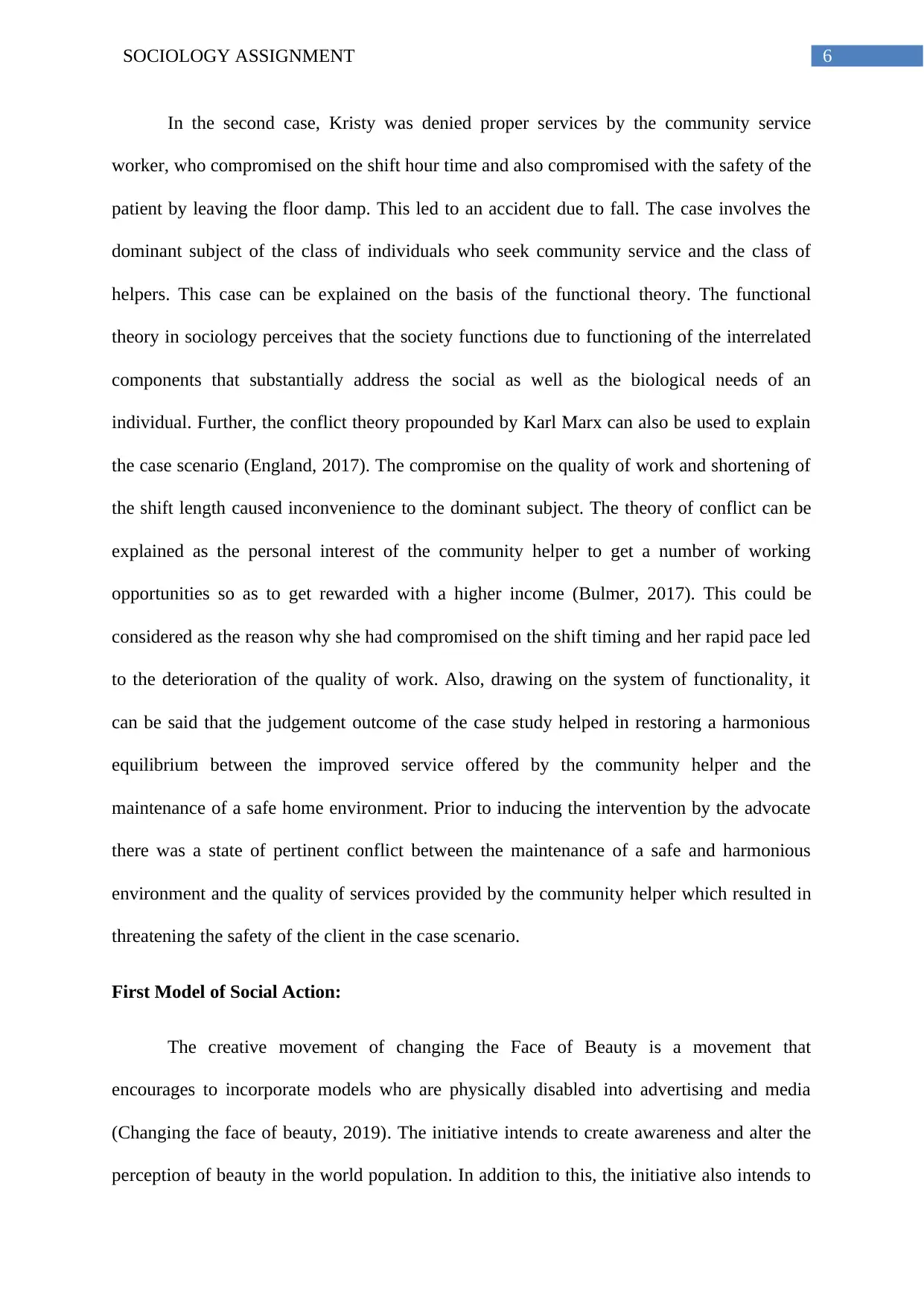
6SOCIOLOGY ASSIGNMENT
In the second case, Kristy was denied proper services by the community service
worker, who compromised on the shift hour time and also compromised with the safety of the
patient by leaving the floor damp. This led to an accident due to fall. The case involves the
dominant subject of the class of individuals who seek community service and the class of
helpers. This case can be explained on the basis of the functional theory. The functional
theory in sociology perceives that the society functions due to functioning of the interrelated
components that substantially address the social as well as the biological needs of an
individual. Further, the conflict theory propounded by Karl Marx can also be used to explain
the case scenario (England, 2017). The compromise on the quality of work and shortening of
the shift length caused inconvenience to the dominant subject. The theory of conflict can be
explained as the personal interest of the community helper to get a number of working
opportunities so as to get rewarded with a higher income (Bulmer, 2017). This could be
considered as the reason why she had compromised on the shift timing and her rapid pace led
to the deterioration of the quality of work. Also, drawing on the system of functionality, it
can be said that the judgement outcome of the case study helped in restoring a harmonious
equilibrium between the improved service offered by the community helper and the
maintenance of a safe home environment. Prior to inducing the intervention by the advocate
there was a state of pertinent conflict between the maintenance of a safe and harmonious
environment and the quality of services provided by the community helper which resulted in
threatening the safety of the client in the case scenario.
First Model of Social Action:
The creative movement of changing the Face of Beauty is a movement that
encourages to incorporate models who are physically disabled into advertising and media
(Changing the face of beauty, 2019). The initiative intends to create awareness and alter the
perception of beauty in the world population. In addition to this, the initiative also intends to
In the second case, Kristy was denied proper services by the community service
worker, who compromised on the shift hour time and also compromised with the safety of the
patient by leaving the floor damp. This led to an accident due to fall. The case involves the
dominant subject of the class of individuals who seek community service and the class of
helpers. This case can be explained on the basis of the functional theory. The functional
theory in sociology perceives that the society functions due to functioning of the interrelated
components that substantially address the social as well as the biological needs of an
individual. Further, the conflict theory propounded by Karl Marx can also be used to explain
the case scenario (England, 2017). The compromise on the quality of work and shortening of
the shift length caused inconvenience to the dominant subject. The theory of conflict can be
explained as the personal interest of the community helper to get a number of working
opportunities so as to get rewarded with a higher income (Bulmer, 2017). This could be
considered as the reason why she had compromised on the shift timing and her rapid pace led
to the deterioration of the quality of work. Also, drawing on the system of functionality, it
can be said that the judgement outcome of the case study helped in restoring a harmonious
equilibrium between the improved service offered by the community helper and the
maintenance of a safe home environment. Prior to inducing the intervention by the advocate
there was a state of pertinent conflict between the maintenance of a safe and harmonious
environment and the quality of services provided by the community helper which resulted in
threatening the safety of the client in the case scenario.
First Model of Social Action:
The creative movement of changing the Face of Beauty is a movement that
encourages to incorporate models who are physically disabled into advertising and media
(Changing the face of beauty, 2019). The initiative intends to create awareness and alter the
perception of beauty in the world population. In addition to this, the initiative also intends to
Paraphrase This Document
Need a fresh take? Get an instant paraphrase of this document with our AI Paraphraser
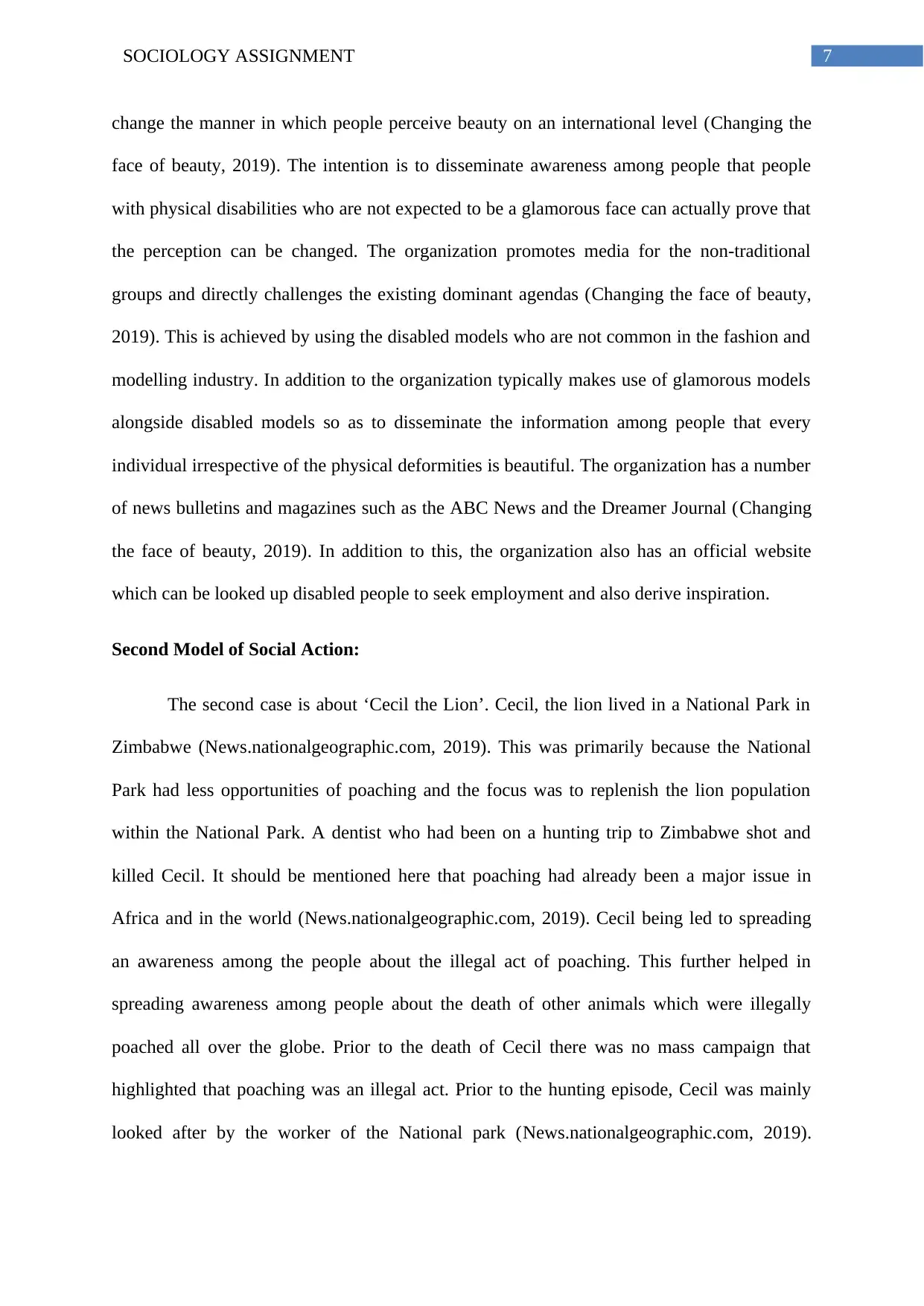
7SOCIOLOGY ASSIGNMENT
change the manner in which people perceive beauty on an international level (Changing the
face of beauty, 2019). The intention is to disseminate awareness among people that people
with physical disabilities who are not expected to be a glamorous face can actually prove that
the perception can be changed. The organization promotes media for the non-traditional
groups and directly challenges the existing dominant agendas (Changing the face of beauty,
2019). This is achieved by using the disabled models who are not common in the fashion and
modelling industry. In addition to the organization typically makes use of glamorous models
alongside disabled models so as to disseminate the information among people that every
individual irrespective of the physical deformities is beautiful. The organization has a number
of news bulletins and magazines such as the ABC News and the Dreamer Journal (Changing
the face of beauty, 2019). In addition to this, the organization also has an official website
which can be looked up disabled people to seek employment and also derive inspiration.
Second Model of Social Action:
The second case is about ‘Cecil the Lion’. Cecil, the lion lived in a National Park in
Zimbabwe (News.nationalgeographic.com, 2019). This was primarily because the National
Park had less opportunities of poaching and the focus was to replenish the lion population
within the National Park. A dentist who had been on a hunting trip to Zimbabwe shot and
killed Cecil. It should be mentioned here that poaching had already been a major issue in
Africa and in the world (News.nationalgeographic.com, 2019). Cecil being led to spreading
an awareness among the people about the illegal act of poaching. This further helped in
spreading awareness among people about the death of other animals which were illegally
poached all over the globe. Prior to the death of Cecil there was no mass campaign that
highlighted that poaching was an illegal act. Prior to the hunting episode, Cecil was mainly
looked after by the worker of the National park (News.nationalgeographic.com, 2019).
change the manner in which people perceive beauty on an international level (Changing the
face of beauty, 2019). The intention is to disseminate awareness among people that people
with physical disabilities who are not expected to be a glamorous face can actually prove that
the perception can be changed. The organization promotes media for the non-traditional
groups and directly challenges the existing dominant agendas (Changing the face of beauty,
2019). This is achieved by using the disabled models who are not common in the fashion and
modelling industry. In addition to the organization typically makes use of glamorous models
alongside disabled models so as to disseminate the information among people that every
individual irrespective of the physical deformities is beautiful. The organization has a number
of news bulletins and magazines such as the ABC News and the Dreamer Journal (Changing
the face of beauty, 2019). In addition to this, the organization also has an official website
which can be looked up disabled people to seek employment and also derive inspiration.
Second Model of Social Action:
The second case is about ‘Cecil the Lion’. Cecil, the lion lived in a National Park in
Zimbabwe (News.nationalgeographic.com, 2019). This was primarily because the National
Park had less opportunities of poaching and the focus was to replenish the lion population
within the National Park. A dentist who had been on a hunting trip to Zimbabwe shot and
killed Cecil. It should be mentioned here that poaching had already been a major issue in
Africa and in the world (News.nationalgeographic.com, 2019). Cecil being led to spreading
an awareness among the people about the illegal act of poaching. This further helped in
spreading awareness among people about the death of other animals which were illegally
poached all over the globe. Prior to the death of Cecil there was no mass campaign that
highlighted that poaching was an illegal act. Prior to the hunting episode, Cecil was mainly
looked after by the worker of the National park (News.nationalgeographic.com, 2019).
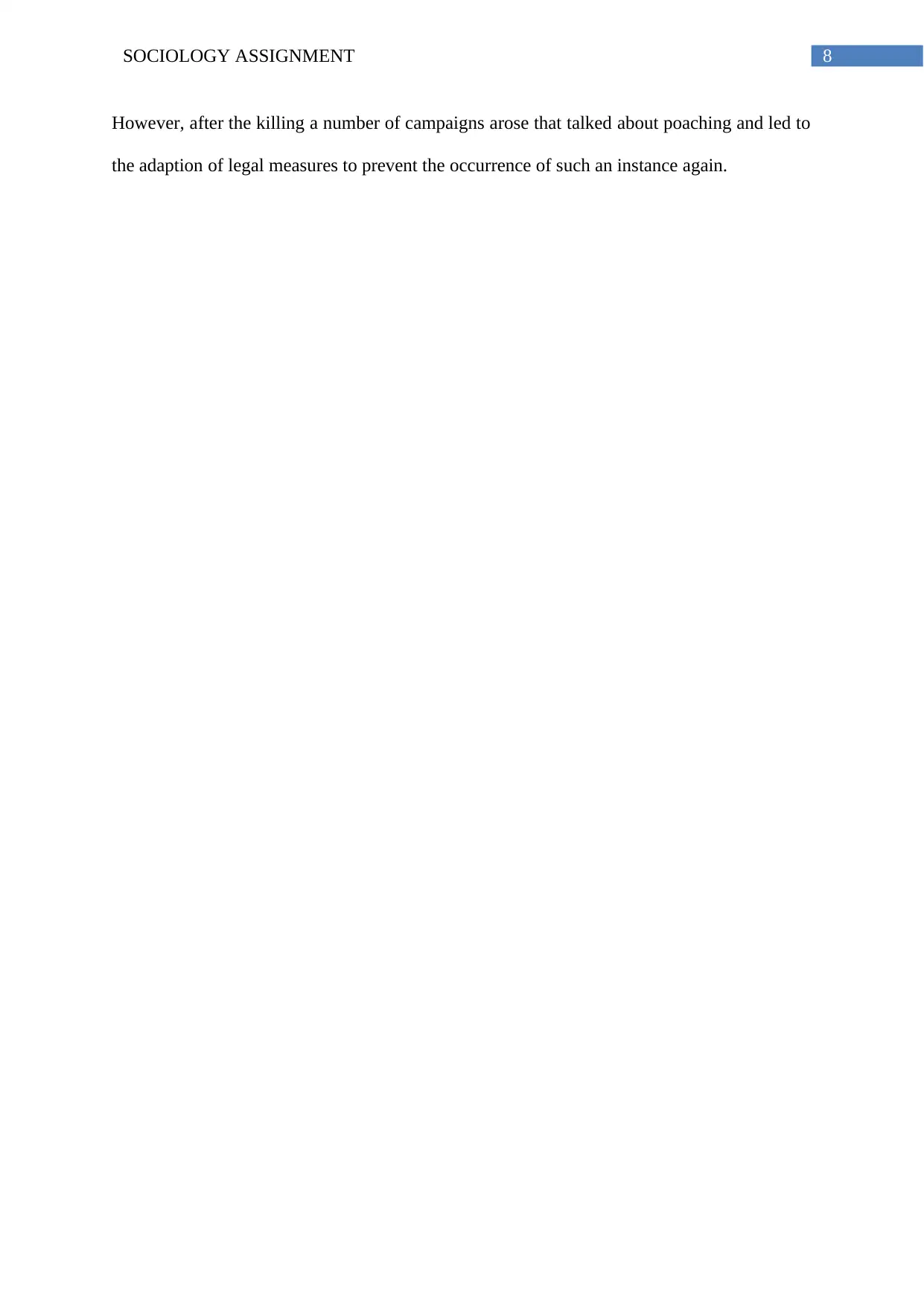
8SOCIOLOGY ASSIGNMENT
However, after the killing a number of campaigns arose that talked about poaching and led to
the adaption of legal measures to prevent the occurrence of such an instance again.
However, after the killing a number of campaigns arose that talked about poaching and led to
the adaption of legal measures to prevent the occurrence of such an instance again.
⊘ This is a preview!⊘
Do you want full access?
Subscribe today to unlock all pages.

Trusted by 1+ million students worldwide
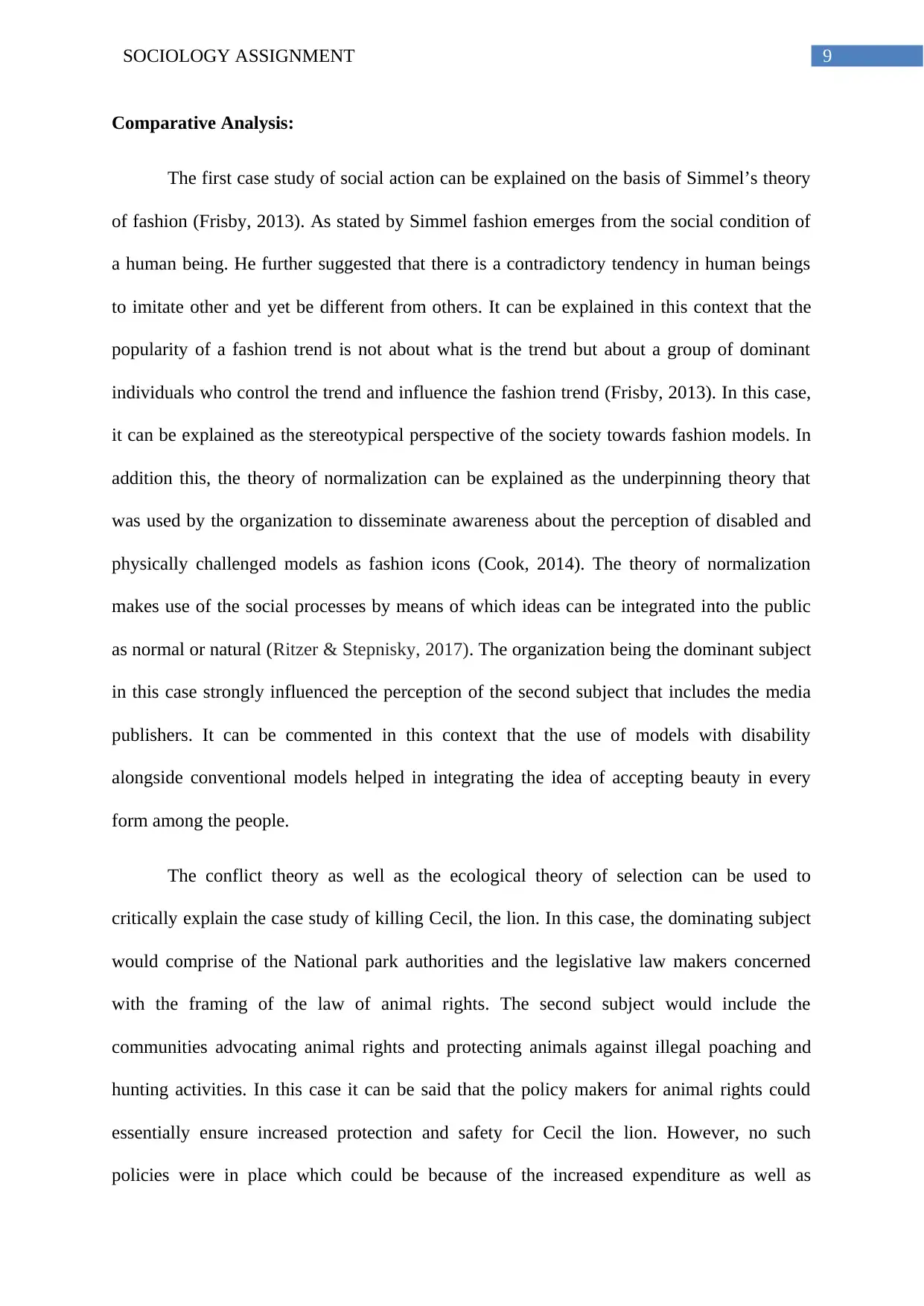
9SOCIOLOGY ASSIGNMENT
Comparative Analysis:
The first case study of social action can be explained on the basis of Simmel’s theory
of fashion (Frisby, 2013). As stated by Simmel fashion emerges from the social condition of
a human being. He further suggested that there is a contradictory tendency in human beings
to imitate other and yet be different from others. It can be explained in this context that the
popularity of a fashion trend is not about what is the trend but about a group of dominant
individuals who control the trend and influence the fashion trend (Frisby, 2013). In this case,
it can be explained as the stereotypical perspective of the society towards fashion models. In
addition this, the theory of normalization can be explained as the underpinning theory that
was used by the organization to disseminate awareness about the perception of disabled and
physically challenged models as fashion icons (Cook, 2014). The theory of normalization
makes use of the social processes by means of which ideas can be integrated into the public
as normal or natural (Ritzer & Stepnisky, 2017). The organization being the dominant subject
in this case strongly influenced the perception of the second subject that includes the media
publishers. It can be commented in this context that the use of models with disability
alongside conventional models helped in integrating the idea of accepting beauty in every
form among the people.
The conflict theory as well as the ecological theory of selection can be used to
critically explain the case study of killing Cecil, the lion. In this case, the dominating subject
would comprise of the National park authorities and the legislative law makers concerned
with the framing of the law of animal rights. The second subject would include the
communities advocating animal rights and protecting animals against illegal poaching and
hunting activities. In this case it can be said that the policy makers for animal rights could
essentially ensure increased protection and safety for Cecil the lion. However, no such
policies were in place which could be because of the increased expenditure as well as
Comparative Analysis:
The first case study of social action can be explained on the basis of Simmel’s theory
of fashion (Frisby, 2013). As stated by Simmel fashion emerges from the social condition of
a human being. He further suggested that there is a contradictory tendency in human beings
to imitate other and yet be different from others. It can be explained in this context that the
popularity of a fashion trend is not about what is the trend but about a group of dominant
individuals who control the trend and influence the fashion trend (Frisby, 2013). In this case,
it can be explained as the stereotypical perspective of the society towards fashion models. In
addition this, the theory of normalization can be explained as the underpinning theory that
was used by the organization to disseminate awareness about the perception of disabled and
physically challenged models as fashion icons (Cook, 2014). The theory of normalization
makes use of the social processes by means of which ideas can be integrated into the public
as normal or natural (Ritzer & Stepnisky, 2017). The organization being the dominant subject
in this case strongly influenced the perception of the second subject that includes the media
publishers. It can be commented in this context that the use of models with disability
alongside conventional models helped in integrating the idea of accepting beauty in every
form among the people.
The conflict theory as well as the ecological theory of selection can be used to
critically explain the case study of killing Cecil, the lion. In this case, the dominating subject
would comprise of the National park authorities and the legislative law makers concerned
with the framing of the law of animal rights. The second subject would include the
communities advocating animal rights and protecting animals against illegal poaching and
hunting activities. In this case it can be said that the policy makers for animal rights could
essentially ensure increased protection and safety for Cecil the lion. However, no such
policies were in place which could be because of the increased expenditure as well as
Paraphrase This Document
Need a fresh take? Get an instant paraphrase of this document with our AI Paraphraser

10SOCIOLOGY ASSIGNMENT
financial costs to ensure added protection of the animals. Further, the theory of ecological
selection suggests that the nature critically selects the organism that is capable of surviving
the environmental stressors without becoming perished (Peet & Hartwick, 2015). In other
words, the theory can be explained as the tendency of the nature to select the fittest organisms
for continuation of species and the elimination of the weaker species. In this case, the human
group that violates the animal rights and practices illegal hunting and poaching for the
purpose of leisure or commercial benefit critically establish themselves as the dominate
subject and at the same time gain an edge over the available resources present within the
environment. It is only after the killing of Cecil, the lion that the impact of losing a species
and the disruption of the environmental equilibrium is understood. In addition to this, the
theory of environmental sociology can also be applied in this context (Environment-
ecology.com, 2019). The theory of environmental sociology clearly explains the functioning
of the society on the basis of human interaction and environmental problems. The theory of
societal-environmental dialectic was propounded by Schnaiberg and it mentions that political
salience indirectly affects the control of the state of conflict (Environment-ecology.com,
2019). This can be interlinked to the aspect of economic synthesis which states that the
human desire would most likely prevail over most of the ecological concerns. The policy
makers would prioritize the expansion of economic growth at the cost of causing damage to
the environment. In addition to this, the priority of the governing bodies would rely upon
adapting control measures to control the environmental disasters that could potentially lead to
economic or health related disasters. The third and the most important aspect of the theory
mentions the assumption of a hypothetical case where the damage impact is severe that
promotes the designing of sustainable policies. The primary driving factor in this case is not
the environmental degradation but the mass scale economic destruction caused by the
degradation (Environment-ecology.com, 2019). The same can be explained where the death
financial costs to ensure added protection of the animals. Further, the theory of ecological
selection suggests that the nature critically selects the organism that is capable of surviving
the environmental stressors without becoming perished (Peet & Hartwick, 2015). In other
words, the theory can be explained as the tendency of the nature to select the fittest organisms
for continuation of species and the elimination of the weaker species. In this case, the human
group that violates the animal rights and practices illegal hunting and poaching for the
purpose of leisure or commercial benefit critically establish themselves as the dominate
subject and at the same time gain an edge over the available resources present within the
environment. It is only after the killing of Cecil, the lion that the impact of losing a species
and the disruption of the environmental equilibrium is understood. In addition to this, the
theory of environmental sociology can also be applied in this context (Environment-
ecology.com, 2019). The theory of environmental sociology clearly explains the functioning
of the society on the basis of human interaction and environmental problems. The theory of
societal-environmental dialectic was propounded by Schnaiberg and it mentions that political
salience indirectly affects the control of the state of conflict (Environment-ecology.com,
2019). This can be interlinked to the aspect of economic synthesis which states that the
human desire would most likely prevail over most of the ecological concerns. The policy
makers would prioritize the expansion of economic growth at the cost of causing damage to
the environment. In addition to this, the priority of the governing bodies would rely upon
adapting control measures to control the environmental disasters that could potentially lead to
economic or health related disasters. The third and the most important aspect of the theory
mentions the assumption of a hypothetical case where the damage impact is severe that
promotes the designing of sustainable policies. The primary driving factor in this case is not
the environmental degradation but the mass scale economic destruction caused by the
degradation (Environment-ecology.com, 2019). The same can be explained where the death
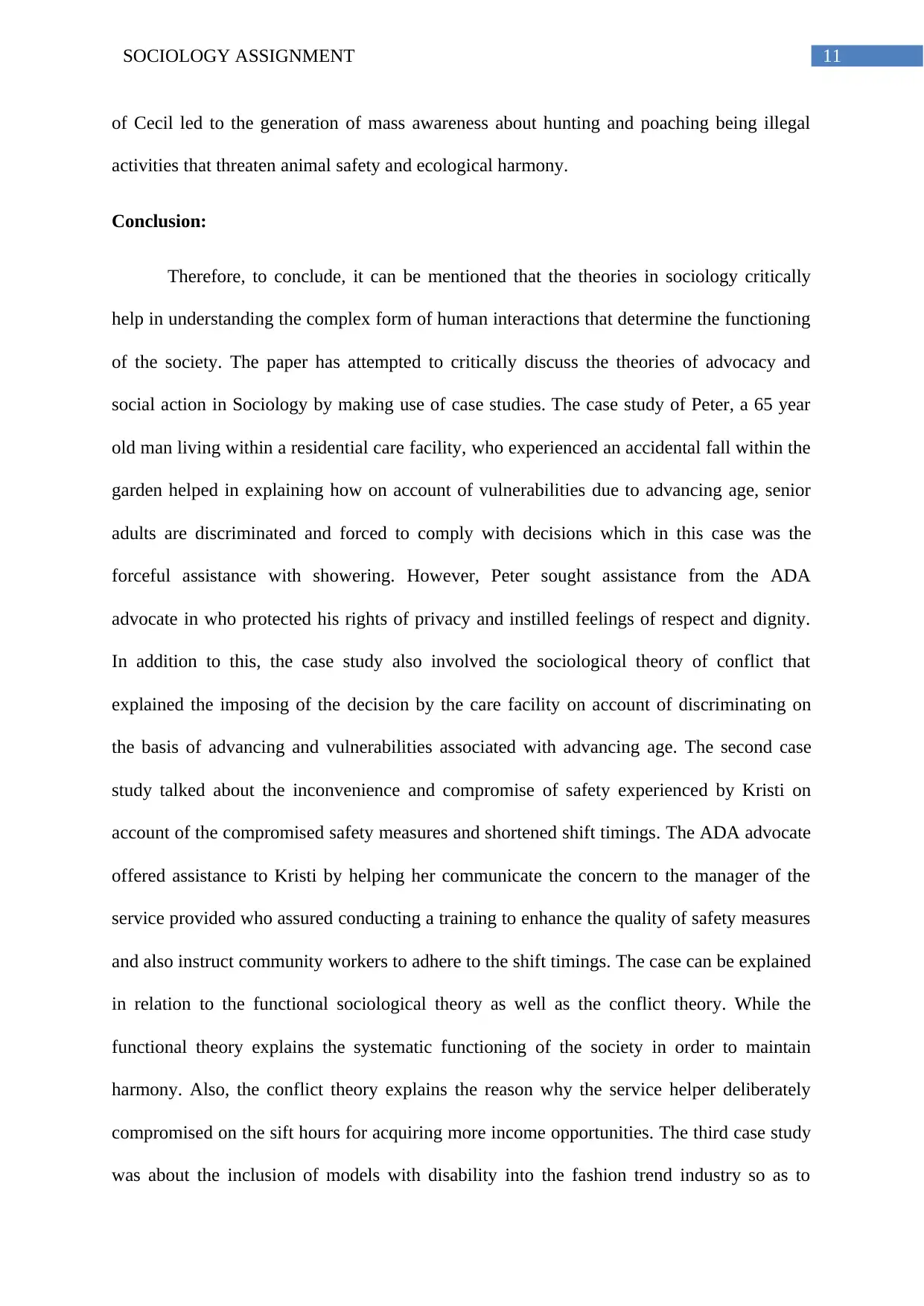
11SOCIOLOGY ASSIGNMENT
of Cecil led to the generation of mass awareness about hunting and poaching being illegal
activities that threaten animal safety and ecological harmony.
Conclusion:
Therefore, to conclude, it can be mentioned that the theories in sociology critically
help in understanding the complex form of human interactions that determine the functioning
of the society. The paper has attempted to critically discuss the theories of advocacy and
social action in Sociology by making use of case studies. The case study of Peter, a 65 year
old man living within a residential care facility, who experienced an accidental fall within the
garden helped in explaining how on account of vulnerabilities due to advancing age, senior
adults are discriminated and forced to comply with decisions which in this case was the
forceful assistance with showering. However, Peter sought assistance from the ADA
advocate in who protected his rights of privacy and instilled feelings of respect and dignity.
In addition to this, the case study also involved the sociological theory of conflict that
explained the imposing of the decision by the care facility on account of discriminating on
the basis of advancing and vulnerabilities associated with advancing age. The second case
study talked about the inconvenience and compromise of safety experienced by Kristi on
account of the compromised safety measures and shortened shift timings. The ADA advocate
offered assistance to Kristi by helping her communicate the concern to the manager of the
service provided who assured conducting a training to enhance the quality of safety measures
and also instruct community workers to adhere to the shift timings. The case can be explained
in relation to the functional sociological theory as well as the conflict theory. While the
functional theory explains the systematic functioning of the society in order to maintain
harmony. Also, the conflict theory explains the reason why the service helper deliberately
compromised on the sift hours for acquiring more income opportunities. The third case study
was about the inclusion of models with disability into the fashion trend industry so as to
of Cecil led to the generation of mass awareness about hunting and poaching being illegal
activities that threaten animal safety and ecological harmony.
Conclusion:
Therefore, to conclude, it can be mentioned that the theories in sociology critically
help in understanding the complex form of human interactions that determine the functioning
of the society. The paper has attempted to critically discuss the theories of advocacy and
social action in Sociology by making use of case studies. The case study of Peter, a 65 year
old man living within a residential care facility, who experienced an accidental fall within the
garden helped in explaining how on account of vulnerabilities due to advancing age, senior
adults are discriminated and forced to comply with decisions which in this case was the
forceful assistance with showering. However, Peter sought assistance from the ADA
advocate in who protected his rights of privacy and instilled feelings of respect and dignity.
In addition to this, the case study also involved the sociological theory of conflict that
explained the imposing of the decision by the care facility on account of discriminating on
the basis of advancing and vulnerabilities associated with advancing age. The second case
study talked about the inconvenience and compromise of safety experienced by Kristi on
account of the compromised safety measures and shortened shift timings. The ADA advocate
offered assistance to Kristi by helping her communicate the concern to the manager of the
service provided who assured conducting a training to enhance the quality of safety measures
and also instruct community workers to adhere to the shift timings. The case can be explained
in relation to the functional sociological theory as well as the conflict theory. While the
functional theory explains the systematic functioning of the society in order to maintain
harmony. Also, the conflict theory explains the reason why the service helper deliberately
compromised on the sift hours for acquiring more income opportunities. The third case study
was about the inclusion of models with disability into the fashion trend industry so as to
⊘ This is a preview!⊘
Do you want full access?
Subscribe today to unlock all pages.

Trusted by 1+ million students worldwide
1 out of 15
Related Documents
Your All-in-One AI-Powered Toolkit for Academic Success.
+13062052269
info@desklib.com
Available 24*7 on WhatsApp / Email
![[object Object]](/_next/static/media/star-bottom.7253800d.svg)
Unlock your academic potential
Copyright © 2020–2025 A2Z Services. All Rights Reserved. Developed and managed by ZUCOL.





